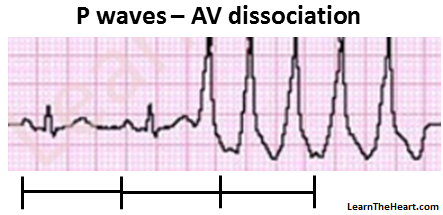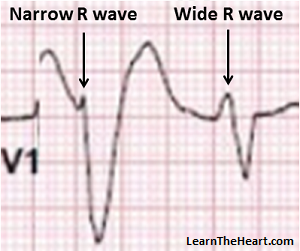General Cardiology Part 5
The Brugada criteria/algorithm is below:
1. Do you see concordance present in the precordial leads (leads V1-V6)?
Also sometime explained as the absence of an RS complex, concordance is diagnostic of VT. A simple way to think of this would be to ask the question, are all of the QRS complexes completely upright or completely downward in the precordial leads? If the answer is yes, then VT is the diagnosis.
2. Is the R to S interval > 100 ms in any one precordial lead?
If present, then VT is the diagnosis. Simply use calipers to measure the distance between the R wave to S wave in each precordial lead and see if it exceeds 100 ms.
3. Do you see atrioventricular (AV) dissociation?
If present, the diagnosis is ventricular tachycardia.
AV dissociation occurs when P wave (represents atrial depolarization) are seen at different rates than the QRS complex. This is present in only a small percentage of ventricular tachycardia ECG tracings, however is diagnostic of VT. Frequently, this is difficult to see due to the fast rate of the QRS complex. Below is an ECG strip of a ptient with ventricular tachycardia. See the P-P inteval when in sinus rhythm then march out the P waves within the wide QRS complex to find the AV dissociation that is present confirming the diagnosis of ventricular tachycardia:
4. Examine the morphology of the QRS complex to see if it meets the below specific criteria for VT as below.
VT is frequently either in a right bundle branch block pattern (upright in V1) or a left bundle branch block pattern (downward in V1).
If upward in lead V1 (RBBB pattern), then VT is present in the following situations:
-
A monophasic R or biphasic qR complex in V1.
- If an RSR’ pattern (“bunny-ear”) is present in V1 with the R peak being higher in amplitude than the R’ peak, the VT is present (see image below).
- A rS complex in lead V6 favors VT
If downward in lead V1 (LBBB pattern), then VT is present in the following situations:
- The presence of any Q or QS wave in lead V6 favors VT
- A wide R wave in lead V1 or V2 of 40 ms or more favors VT (see below image)
- Slurred or notched downstroke of the S wave in V1 or V2 favors VT
- Duration of onset of QRS complex to peak of QS or S wave > 60 ms favors VT
A fusion beat (a.k.a. Dressler beat) occurs during ventricular tachycardia. This occurs when sinus node activity (P wave) begins to conduct through the normal conduction pathway during an episode of ventricular tachycardia. The abnormal ventricular impulse then conducts retrograde across the AV node and the resulting QRS is a “fusion beat” of the normal QRS morphology and that of the ventricular morphology from the ventricular tachycardia.
A “capture beat” is similar to a fusion beat, except the QRS morphology looks completely like the normal QRS complex since sinus node impulse conducts to the ventricles before the retrograde ventricular activation occurs.
Below are multiple 12-lead ECG examples of varying ventricular tachycardias:
- Accelerated Idioventricular Rhythm - Slow VT ECG (Example 1)
- Accelerated Idioventricular Rhythm - Slow VT ECG (Example 2)
- Accelerated Idioventricular Rhythm - Slow VT ECG (Example 3)
- Bidirectional Ventricular Tachycardia ECG
- Monomorphic Non-Sustained Ventricular Tachycardia ECG (Example 1)
- Monomorphic Non-Sustained Ventricular Tachycardia ECG (Example 2)
- Monomorphic Sustained Ventricular Tachycardia ECG (Example 1)
- Monomorphic Sustained Ventricular Tachycardia ECG (Example 2)
- Monomorphic Sustained Ventricular Tachycardia ECG (Example 3)
- Monomorphic Sustained Ventricular Tachycardia ECG (Example 4)
- Monomorphic Sustained Ventricular Tachycardia ECG (Example 5)
- Monomorphic Sustained Ventricular Tachycardia ECG (Example 6)
- Monomorphic Sustained Ventricular Tachycardia with Anti-Tachycardia Pacing (ATP) ECG
- Polymorphic Non-Sustained Ventricular Tachycardia ECG
- Polymorphic Sustained Ventricular Tachycardia ECG



